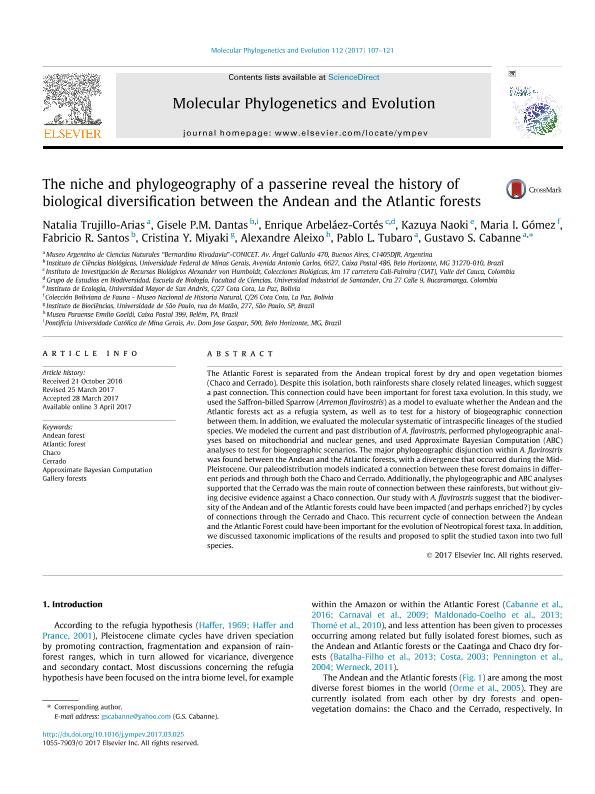Mostrar el registro sencillo del ítem
dc.contributor.author
Trujillo Arias, Natalia

dc.contributor.author
Dantas, Gisele P. M.
dc.contributor.author
Arbeláez Cortés, Enrique
dc.contributor.author
Naoki, Kasuya
dc.contributor.author
Gómez, María Inés

dc.contributor.author
Santos, Fabricio R.

dc.contributor.author
Miyaki, Cristina Y.
dc.contributor.author
Aleixo, Alexandre
dc.contributor.author
Tubaro, Pablo Luis

dc.contributor.author
Cabanne, Gustavo Sebastián

dc.date.available
2018-06-21T19:19:06Z
dc.date.issued
2017-07
dc.identifier.citation
Trujillo Arias, Natalia; Dantas, Gisele P. M.; Arbeláez Cortés, Enrique; Naoki, Kasuya; Gómez, María Inés; et al.; The niche and phylogeography of a passerine reveal the history of biological diversification between the Andean and the Atlantic forests; Academic Press Inc Elsevier Science; Molecular Phylogenetics and Evolution; 112; 7-2017; 107-121
dc.identifier.issn
1055-7903
dc.identifier.uri
http://hdl.handle.net/11336/49584
dc.description.abstract
The Atlantic Forest is separated from the Andean tropical forest by dry and open vegetation biomes (Chaco and Cerrado). Despite this isolation, both rainforests share closely related lineages, which suggest a past connection. This connection could have been important for forest taxa evolution. In this study, we used the Saffron-billed Sparrow (Arremon flavirostris) as a model to evaluate whether the Andean and the Atlantic forests act as a refugia system, as well as to test for a history of biogeographic connection between them. In addition, we evaluated the molecular systematic of intraspecific lineages of the studied species. We modeled the current and past distribution of A. flavirostris, performed phylogeographic analyses based on mitochondrial and nuclear genes, and used Approximate Bayesian Computation (ABC) analyses to test for biogeographic scenarios. The major phylogeographic disjunction within A. flavirostris was found between the Andean and the Atlantic forests, with a divergence that occurred during the Mid-Pleistocene. Our paleodistribution models indicated a connection between these forest domains in different periods and through both the Chaco and Cerrado. Additionally, the phylogeographic and ABC analyses supported that the Cerrado was the main route of connection between these rainforests, but without giving decisive evidence against a Chaco connection. Our study with A. flavirostris suggest that the biodiversity of the Andean and of the Atlantic forests could have been impacted (and perhaps enriched?) by cycles of connections through the Cerrado and Chaco. This recurrent cycle of connection between the Andean and the Atlantic Forest could have been important for the evolution of Neotropical forest taxa. In addition, we discussed taxonomic implications of the results and proposed to split the studied taxon into two full species.
dc.format
application/pdf
dc.language.iso
eng
dc.publisher
Academic Press Inc Elsevier Science

dc.rights
info:eu-repo/semantics/openAccess
dc.rights.uri
https://creativecommons.org/licenses/by-nc-sa/2.5/ar/
dc.subject
Andean Forest
dc.subject
Approximate Bayesian Computation
dc.subject
Atlantic Forest
dc.subject
Cerrado
dc.subject
Chaco
dc.subject
Gallery Forests
dc.subject.classification
Otras Ciencias Biológicas

dc.subject.classification
Ciencias Biológicas

dc.subject.classification
CIENCIAS NATURALES Y EXACTAS

dc.title
The niche and phylogeography of a passerine reveal the history of biological diversification between the Andean and the Atlantic forests
dc.type
info:eu-repo/semantics/article
dc.type
info:ar-repo/semantics/artículo
dc.type
info:eu-repo/semantics/publishedVersion
dc.date.updated
2018-06-04T13:53:12Z
dc.identifier.eissn
1095-9513
dc.journal.volume
112
dc.journal.pagination
107-121
dc.journal.pais
Estados Unidos

dc.journal.ciudad
Amsterdam
dc.description.fil
Fil: Trujillo Arias, Natalia. Consejo Nacional de Investigaciones Científicas y Técnicas. Oficina de Coordinación Administrativa Parque Centenario. Museo Argentino de Ciencias Naturales “Bernardino Rivadavia”; Argentina
dc.description.fil
Fil: Dantas, Gisele P. M.. Universidade Federal de Minas Gerais; Brasil. Pontifícia Universidade Católica de Mina Gerais; Brasil
dc.description.fil
Fil: Arbeláez Cortés, Enrique. Instituto de Investigación de Recursos Biológicos Alexander von Humboldt; Colombia. Universidad Industrial de Santander; Colombia
dc.description.fil
Fil: Naoki, Kasuya. Universidad Mayor de San Andrés; Bolivia
dc.description.fil
Fil: Gómez, María Inés. Museo Nacional de Historia Natural; Bolivia
dc.description.fil
Fil: Santos, Fabricio R.. Universidade Federal de Minas Gerais; Brasil
dc.description.fil
Fil: Miyaki, Cristina Y.. Universidade de Sao Paulo; Brasil
dc.description.fil
Fil: Aleixo, Alexandre. Museu Paraense Emilio Goeldi; Brasil
dc.description.fil
Fil: Tubaro, Pablo Luis. Consejo Nacional de Investigaciones Científicas y Técnicas. Oficina de Coordinación Administrativa Parque Centenario. Museo Argentino de Ciencias Naturales “Bernardino Rivadavia”; Argentina
dc.description.fil
Fil: Cabanne, Gustavo Sebastián. Consejo Nacional de Investigaciones Científicas y Técnicas. Oficina de Coordinación Administrativa Parque Centenario. Museo Argentino de Ciencias Naturales “Bernardino Rivadavia”; Argentina
dc.journal.title
Molecular Phylogenetics and Evolution

dc.relation.alternativeid
info:eu-repo/semantics/altIdentifier/url/https://www.sciencedirect.com/science/article/pii/S1055790317302695
dc.relation.alternativeid
info:eu-repo/semantics/altIdentifier/doi/http://dx.doi.org/10.1016/j.ympev.2017.03.025
Archivos asociados
